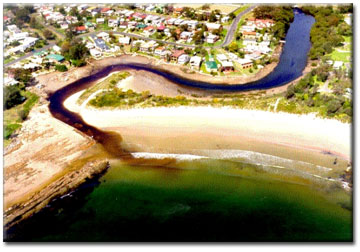What is a Watershed?
Purpose of Watershed Protection
Lake Huron Watersheds
Bi-National Partnership
Contact Us
Home > Pollutants > Point Source Pollution
The U.S. Environmental Protection Agency (EPA) defines point source pollution as “any single identifiable source of pollution from which pollutants are discharged, such as a pipe, ditch, ship or factory smokestack.”
 Point Source Pollution is easier to identify and control than Non-Point Source Pollution. Factories and sewage treatment plants are two common types of point sources. Factories, including oil refineries, pulp and paper mills, and chemical, electronics and automobile manufacturers, typically discharge one or more pollutants in their discharged waters (called effluents). Some factories discharge their effluents directly into a water body. Others treat it themselves before it is released, and still others send their wastes to sewage treatment Picture: Missouri DOT plants for treatment. Sewage treatment plants treat human wastes and send the treated effluent to a stream or river.
Point Source Pollution is easier to identify and control than Non-Point Source Pollution. Factories and sewage treatment plants are two common types of point sources. Factories, including oil refineries, pulp and paper mills, and chemical, electronics and automobile manufacturers, typically discharge one or more pollutants in their discharged waters (called effluents). Some factories discharge their effluents directly into a water body. Others treat it themselves before it is released, and still others send their wastes to sewage treatment Picture: Missouri DOT plants for treatment. Sewage treatment plants treat human wastes and send the treated effluent to a stream or river.
Unregulated discharges from point sources can result in water pollution and unsafe drinking water, and can restrict activities like fishing and swimming. Some of the chemicals discharged by point sources are harmless, but others are toxic to people and wildlife. Whether a discharged chemical is harmful to the aquatic environment depends on a number of factors, including the type of chemical, its concentration, the timing of its release, weather conditions, and the organisms living in the area.
Large farms that raise livestock, such as cows, pigs and chickens, are other sources of point source pollution. These types of farms are known as concentrated animal feeding operations (CAFOs). If they do not treat their animals' waste materials, these substances can then enter nearby waterbodies as raw sewage.
To control point source discharges, the Clean Water Act established the National Pollutant Discharge Elimination System (NPDES). Under the NPDES program, factories, sewage treatment plants, and other point sources must obtain a permit from the state and EPA before they can discharge their waste or effluents into any body of water. Prior to discharge, the point source must use the latest technologies available to treat its effluents and reduce the level of pollutants. If necessary, a second, more stringent set of controls can be placed on a point source to protect a specific water body.
Source: NOAA Ocean Service Education
Northeast Michigan Council of Governments
80 Livingston Blvd. | PO Box 457
Gaylord, MI 49734
(989) 705-3730 | nemcog.org


